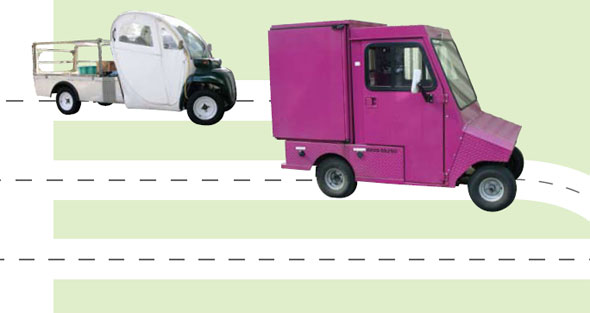It's cute! It's clean! It's a SLACmobile!
 |
|
Plugged into a weatherproof outlet behind SLAC's Test Laboratory, what looks like an oversized green-and-silver go-cart waits with its load of tools and paint supplies. It's part of a fleet of pint-sized economobiles that have carried people, materials, and equipment around SLAC National Accelerator Laboratory since the lab's early days. |
It all started with trikes.
“The linac was full of threewheeled bicycles way back when,” says SLAC fleet services garage supervisor Al Manuel. In the mid-60s, he says, SLACers pedaled tricycles up and down the Klystron Gallery that serves the lab's two-mile linear accelerator.
Over time the trikes gave way to three-wheeled Cushman carts, former US Post Office vehicles powered by gasoline. By the early 1980s, electric four-wheelers began to appear. More than 50 of those jaunty flatbeds and microvans, some painted orange, red, or purple, carry ladders, mail, or library books across the site and around the mile-long PEP Ring Road. Manuel's group keeps them running, alongside the mopeds and low-speed gas vehicles that have since joined the fleet.
For some of the older vehicles “a lot of repair parts are not available any more,” says SLAC Transportation Manager Ken Rubino, so workers salvage parts from others that are beyond repair.
As SLACmobiles go out of service, the fleet changes composition. At one time, Rubino says, scores of mopeds zipped around SLAC. Now the balance has shifted in favor of small-appetite gas vehicles and electric carts. The fleet's users treat their wheels with some affection. One cart's cab sports a pair of bull's horns. Volunteers spruced up a second with removable flame stickers and a set of fuzzy dice for founding SLAC Director Pief Panofsky, who died in 2007.
“Pief loved it,” says Ellie Lwin, Panofsky's assistant at the time, who spearheaded creation of the Piefmobile—even paying for the materials herself—as a surprise for him.
SLAC's 15 gas-powered mini-pickups and vans get up to 50 miles to the gallon, thanks to their three-cylinder engines and light weight. But most of today's fleet runs on electricity. If the United States plays its cards right with solar and wind power, more SLACmobiles could run on sunshine and fresh air in the years to come.
Shawne Workman
Click here to download the pdf version of this article.






